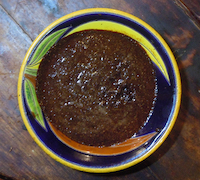 Posted by onawah
(here)
Industry Scandal: The Loss of Nutrients
Posted by onawah
(here)
Industry Scandal: The Loss of Nutrients
by Dr. Joseph Mercola
November 02, 2024
https://articles.mercola.com/sites/a...&rid=154123558
https://media.mercola.com/ImageServe...t-loss-pdf.pdf
"Story at-a-glance
Modern farming practices and seed hybridization have significantly reduced the nutritional content of fruits and vegetables over the past 60 years, with average declines of 16% for calcium, 27% for vitamin C and 50% for iron
The focus on higher yields, longer shelf life and visual appeal in crop development has led to a trade-off in nutrient density, particularly evident in hybrid tomatoes compared to heirloom varieties
Four multinational corporations control two-thirds of the global seed market, leading to loss of biodiversity, farmer dependence on hybrid seeds and exploitative labor practices in seed production
The nutrient decline in produce contributes to increased risk of deficiencies, reduced antioxidant intake and rising chronic diseases, leading to greater reliance on dietary supplements
Solutions include supporting seed banks, practicing regenerative agriculture, increasing consumer awareness and implementing policies that prioritize soil health, protect farmers' rights and enforce fair labor practices in seed production
The documentary "Industry Scandal: The Loss of Nutrients" exposes how modern farming practices and seed hybridization have dramatically reduced the nutritional content of our fruits and vegetables over the past 60 years.
The evidence is clear: the food on our plates today is a shadow of what our grandparents ate. Not only has flavor been sacrificed on the altar of productivity and shelf-life, but critical vitamins and minerals have plummeted as well. This nutrient collapse has profound implications for public health that we're only beginning to understand.
The Ghost of Vegetables Past
The filmmakers begin their investigation at an unlikely location — the French Academy of Agriculture. Hidden away in this venerable institution, they discover a food composition table from 60 years ago detailing the exact nutrient content of fruits and vegetables at that time. Armed with this historical data, they set out to compare it to modern nutrient levels. The results are striking:1
"We discovered a little-known fact: fruit and vegetables have lost some of their vitamins and minerals. Take green beans for example: in 1960 they contained 65 milligrams (mg) of calcium for every 100 grams. In 2017 they contain no more than 48.5 milligrams. That's a quarter less calcium. The same thing for vitamin C — 19 mg at the time versus 13.6 mg."
This wasn't an isolated case. Examining data for the 70 most consumed fruits and vegetables revealed an alarming trend. According to the film, which is also known as "Seeds of Profit":2
"The results show a dramatic deterioration in the space of 60 years. All 70 fruit and vegetables have lost an average of 16% of their calcium, 27% of their vitamin C, and almost less than half of their iron levels."
These findings align with research conducted in the U.S. and U.K. American biochemist Donald Davis analyzed nutrient changes in 43 vegetables between 1950 and 1999, reaching similar conclusions.3 Davis’ study found statistically significant declines in six nutrients: protein, calcium, phosphorus, iron, riboflavin and vitamin C.
The median declines ranged from 6% for protein to 38% for riboflavin (vitamin B2), and the researchers suggest that these declines are most likely explained by changes in cultivated varieties between 1950 and 1999. Specifically, they said there may be "trade-offs between crop yield and nutrient content" in the newer varieties.
The Culprit: Agricultural ‘Progress’
What's behind this nutrient collapse? The documentary points to several factors, all stemming from the industrialization of agriculture:
•Hybridization for higher yields — Over the past 50 years, seed companies have focused on developing hybrid varieties that maximize yield and visual appeal. As Davis explains, "I think that most of these declines are caused by increases in yield. When yields go up, there's less nutrients per weight of the food. A lot of agricultural scientists may not know about how big these effects are. This is kind of embarrassing. They're always wanting to increase yield."4
This focus on quantity over quality has come at a steep nutritional cost. The tomato, for instance, has seen some of the largest nutrient declines — losing a quarter of its calcium and more than half of its vitamins.
•The quest for eternal shelf life — Perhaps the most egregious example of sacrificing nutrition for commercial gain is the development of the "long shelf life" tomato. In the 1970s and 1980s, Israeli researchers created a hybrid tomato that decays much more slowly after being picked.
While this innovation reduced waste and revolutionized the global tomato market, it came with serious downsides. As Haim Rabinowitch, professor emeritus at The Hebrew University of Jerusalem, one of the developers, admits:5
"The genes for ripening inhibition carry with them some negative traits. For instance, flavor deteriorates and we [have] less nutrients. But I didn't know because we never measured it. Only later in the '90s and the early 2000s, we started looking into the quality traits. I offered a project like that to many seed companies. I even gave it a name. I called it ‘ACE’ tomato.
Why ACE? Vitamins A, C and E, and I said it will be much healthier tomato. We don't have it in supermarkets, this variety. The industries, they don't care."The Nutrient Gap: Heirloom vs Hybrid
In a revealing experiment, the filmmakers compared a modern hybrid tomato to an heirloom variety. The results were stark:
After one week, the heirloom tomato showed signs of decay and was no longer fit for sale. The hybrid looked unchanged.
After two weeks, the heirloom was moldy. The hybrid still appeared fresh.
It took 25 days for the hybrid to become unsellable — extending shelf life from three days to over three weeks.
But this longevity comes at a steep price. When tasted, the hybrid was described as "tasteless" compared to the flavorful heirloom. To quantify the nutrient differences, the documentary team had both tomatoes analyzed in an accredited laboratory. The results were eye-opening:6
"The hybrid tomato contains a significantly lower level of the five nutrients analyzed. It contains 63% less calcium, 29% less magnesium, and 72% less vitamin C. The levels of lycopene and polyphenols, two antioxidants that help fight cardiovascular diseases, are two times lower in the hybrid than in the farmer's variety tomato."
This data provides clear evidence that the push for longer shelf life and higher yields has dramatically reduced the nutritional value of our produce.
The Global Seed Oligopoly
As the documentary reveals, the push for hybrid seeds is being driven by a handful of multinational corporations that dominate the global seed market. Just four companies — Bayer (formerly Monsanto), Corteva (formerly DuPont), Syngenta and Limagrain — control two-thirds of all seeds sold worldwide.7,8 This concentration of power has serious implications:
1.Loss of biodiversity — As uniform hybrid varieties replace traditional seeds, we're losing genetic diversity at an alarming rate. The Food and Agriculture Organization (FAO) of the United Nations reports that 75% of global agrobiodiversity has been lost due to the adoption of "improved" varieties.9
2.Farmer dependence — Hybrid seeds don't reproduce true-to-type, forcing farmers to buy new seeds each year. This creates a cycle of dependence on seed companies.
3.Skyrocketing seed prices — The documentary reveals that some tomato seed varieties now sell for up to $450,000 per kilogram — more than double the price of gold.10
4.Exploitative labor practices — To keep costs down, seed production is often outsourced to developing countries where child labor and below-minimum wage payments are common.
The Dark Side of Seed Production
The widespread use of child labor in hybrid seed production is featured in the documentary. In India's Karnataka state, a major hub for vegetable seed production, researchers found that 10% of workers in seed fields are children under 14 — despite laws prohibiting child labor.11 Why are children employed? As Davuluri Venkateswarlu, author of "Soiled Seeds," a report on the issue, explains:12
"The hybridization activity is very, very delicate. It requires a lot of skills. The children are preferred because they can do these repetitive activities very faster than adults, and also they are more obedient. Two children can do the work of three adults. That is the kind of calculation farmers have."
Even adult workers face exploitation. Women working in tomato seed fields earn just $2.80 per day — 40% below India's legal minimum wage. Yet these seeds will sell for tens of thousands of dollars per kilogram in Europe and North America.
This exploitation persists because multinational seed companies turn a blind eye to the practices of their local subcontractors. When confronted, they hide behind vague statements about "promoting decent working conditions" without taking concrete action.
The Health Implications
The health implications of this nutrient collapse in our food supply are immense. While the full impact is still being studied, we can draw some alarming conclusions:
1.Increased risk of nutrient deficiencies — As fruits and vegetables contain fewer vitamins and minerals, it becomes harder to meet your nutritional needs through diet alone. This may contribute to the rise in deficiencies we're seeing, particularly in minerals like magnesium and trace elements.
2.Reduced antioxidant intake — The dramatic drop in vitamin C, lycopene and polyphenols means we're getting far fewer protective antioxidants from our produce. This could increase vulnerability to oxidative stress and related chronic diseases.
3.Link to rising chronic disease — While many factors contribute to the increase in chronic diseases like heart disease and diabetes, the depletion of protective nutrients in our food supply plays a role.
4.Hidden hunger — Even people eating what appears to be a healthy diet rich in fruits and vegetables are getting far fewer nutrients than they realize. This "hidden hunger" has wide-ranging health effects.
5.Increased reliance on supplements — As food becomes less nutritious, more people will turn to dietary supplements to meet their nutritional needs. While supplements have their place, they're not a perfect replacement for nutrients obtained from whole foods.
The Path Forward: Reclaiming Our Food
The situation seems dire, but there are rays of hope. Around the world, farmers, researchers and citizens are working to preserve agricultural biodiversity and promote more nutritious food production. Here are some key initiatives:
•Seed banks and exchanges — Organizations like Kokopelli in France are working to preserve heirloom and traditional seed varieties. Their "Seeds Without Borders" program distributes these seeds to farmers and gardeners worldwide, helping to maintain genetic diversity.
As noted in the documentary, "By conserving these endangered seeds, we are taking back the choice to plant or eat non-standardized fruit and vegetables which are the best produce for both our planet and our health."13 Supporting these seed preservation efforts is crucial for maintaining biodiversity and giving farmers alternatives to hybrid seeds.
•Regenerative agriculture — Farming practices that focus on building healthy soils increase the nutrient content of crops. By moving away from chemical-intensive methods and embracing techniques like cover cropping, composting and diverse crop rotations, we can produce more nutritious food while improving environmental health.
•Consumer awareness and demand — As consumers become more aware of the nutrient issue, they can drive change through their purchasing decisions. Choosing heirloom varieties, supporting local farmers using diverse seed stocks and demanding more transparent labeling all make a difference.
•Policy changes — At a broader level, we need policies that incentivize farming practices that enhance soil health and nutrient uptake, protect farmers' rights to save and exchange seeds, and enforce fair labor practices in seed production globally.
How to Protect Your Nutrient Intake and Support a More Nutritious Food System
The loss of nutrients in our food supply is a silent crisis that demands urgent attention. By understanding the problem and taking action — both in our personal choices and by advocating for systemic change — we can work toward a future where our food nourishes us as nature intended.
The path to truly healthy food isn't through further industrialization or genetic modification. Instead, we must look to the wisdom of traditional farming methods, embrace biodiversity and prioritize nutrient density. Our health, and the health of future generations, depends on it. To protect your health and support a more nutritious food system, consider:
Choosing heirloom and open-pollinated varieties when possible — These often have higher nutrient levels and better flavor than hybrid varieties.
Supporting local farmers and farmers markets — Small-scale producers are more likely to grow diverse, nutrient-dense crops.
Grow your own — Even a small garden or a few containers provide incredibly nutritious produce.
Opt for organic — While not a guarantee of higher nutrients, organic produce is less likely to contain harmful pesticide residues.
Eat a diverse diet — Don't rely on just a few fruits and vegetables — incorporate a wide variety to ensure you're getting a broad spectrum of nutrients.
Consider targeted supplementation — While whole foods should be the foundation of your diet, high-quality supplements can help fill nutrient gaps.
Support organizations working to preserve seed diversity and promote sustainable agriculture.
Stay informed and spread awareness — Share this information with friends and family to help drive change.
"
Sources and References
1 YouTube, Moconomy, Industry Scandal: The Loss of Nutrients July 20, 2024, 1:12
2, 4 YouTube, Moconomy, Industry Scandal: The Loss of Nutrients July 20, 2024, 1:53
3 J Am Coll Nutr. 2004 Dec;23(6):669-82. doi: 10.1080/07315724.2004.10719409
5 YouTube, Moconomy, Industry Scandal: The Loss of Nutrients July 20, 2024, 13:10
6 YouTube, Moconomy, Industry Scandal: The Loss of Nutrients July 20, 2024, 20:57
7 Equal Exchange Center, From Alternative Trade to Corporate Consolidation
8 YouTube, Moconomy, Industry Scandal: The Loss of Nutrients July 20, 2024, 43:08
9 FAO.org, What Is Happening to Agrobiodiversity?
10 YouTube, Moconomy, Industry Scandal: The Loss of Nutrients July 20, 2024, 26:47
11 YouTube, Moconomy, Industry Scandal: The Loss of Nutrients July 20, 2024, 27:59
12 YouTube, Moconomy, Industry Scandal: The Loss of Nutrients July 20, 2024, 33:04
13 YouTube, Moconomy, Industry Scandal: The Loss of Nutrients July 20, 2024, 49:06
1):1-3

















 Reply With Quote
Reply With Quote




 )
)








Bookmarks